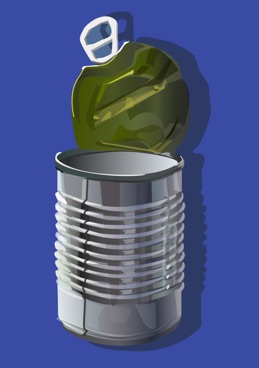Buy a print
TIN CAN
The average Britain uses 4 tins of food every week and across the UK we buy 5.5 billion tin cans every year. This is part of the probable 195 billion used annual around the globe.
Only 63% of these are recycled in the USA compared to 79.5% in Europe. Across the 37 counties who are members of the World Steel Association 7.5 million tonnes of steel cans are recycled every year. Because steel can be recycled again and again, they could come back as more cans, a bicycle or a perhaps a saucepan, saving 11.25 million tones of CO2 and 10.5 million tonnes of iron ore.
HISTORY
The tin can was first patented in France 1810 and turned into a production process in the UK in 1813. The cans were originally sealed with lead solder which was OK for gunpowder, seeds and turpentine which were the first products for the British Navy. But this resulted in cases of food poisoning when later used for food packaging. Some acid foods, such as fruit, can also cause corrosion of the tin layer leading to nausea, vomiting and diarrhoea. Tin Cans are now pressed sealed at the joint and have a coloured inner surface of plastic to stop deterioration.
MANUFACTURE
There are a number of different types of can but most have sides formed from tin coated steel. They are rolled into shape and joined to form cylinders before pressed metal tops are fitted. The open cans are then transported to the food production line where they are filled and the bases are sealed. Hot foods, like soup are often recooked in the sealed can.
DRAWING
Without the label the can is a fine example of simplicity. The cylindrical walls catch the light in a series of vertical bands. These are broken by the horizontal corrugations which reflect the environment. The circular grooves on the lid catch the light and cast shadows in a subtle way across the surface.















